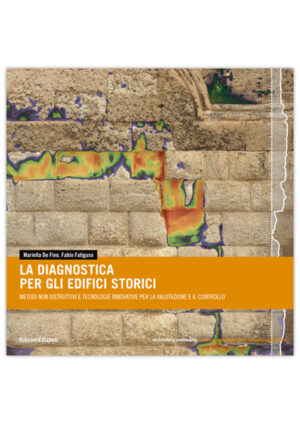Automatic Diagnostics and Monitoring Through Historic Building Information Modelling
15,60€
Digital Technologies to Manage Knowledge and Preservation of Architectural Heritage
Silvana Bruno
eBook in formato PDF
The refurbishment is challenging as it requires efficient organization and analysis of knowledge about historic heritage. It is very critical because of ambiguities of workflows and information exchanges, dispersion of documentation and use of inadequate tools to reduce risks. Academics and professionals are more and more interested in experimenting with innovative methodologies and operative methods to deal with the uncertain context. In this perspective, the book proposes a possible framework for automatic diagnosis and monitoring of historic buildings to support decisions. This framework derives from the gaps in knowledge, methods and tools identified with a critical literature review, finding Historic Building Information Modelling a suitable Information Technology for knowledge base management, reasoning and professional remote collaboration, both with a file-based and a data-based approach. Afterwards, the Diagnosis-aided Historic Building Information Modelling for performance assessment of historical assets has been implemented in each phase: knowledge structuration, data acquisition, parametric modelling, semantic enrichment of diagnostic surveys and real-time monitoring with file-based management and web-based documentation, analysis and sharing through a cloud-based HBIM platform. The DA-HBIMM has been tested on national and international historic buildings.
CONTENTS
Abstract
Introduction
1. Innovative approaches in refurbishment
1.1. The role of incremental knowledge in refurbishment
1.2. Innovative managemement of integrated data and information
2. State of the art
2.1. Literature review methodology
2.2. Data collection and bibliometric approach about HBIM
2.3. Critical analysis
2.4. HBIM model, diagnosis and performance assessment
2.5. Gaps in knowledge and future developments in HBIM for performance assessment
2.6. Latest research progresses
3. A methodological approach for implementing performance assessment in HBIM for historical assets (DA-HBIMM)
3.1. Toward Diagnosis-aided Historic Building Information Modelling
3.2. Guidelines for knowledge structuration and work organization [OKS]
3.3. Surveying as-is/as-damaged conditions [RE]
3.4. Parametric modelling [Scan2BIM]
3.5. Semantic enrichment [PA]
3.6. Automated diagnosis via DA-HBIMM [MDA]
4. Testing the DA-HBIMM approach
4.1. Overview of case studies
4.2. Knowledge structuration and HBIM project excecution process map
4.3. Data acquisition and parametric modelling
4.4. Testing the degree of automation in parametric modelling
4.5. Semantic enrichment
4.6. File-based management of diagnostic surveys
4.7. Testing the automatic diagnosis via DA-HBIMM
4.8. Web-based documentation, analysis and sharing: the Cloud HBIM portal
5. Results and discussion
5.1. Structuration of results and discussion
5.2. Results in reverse engineering: data acquisition and parametric modelling
5.3. Developments and shortcomings of semantic enrichment methods
5.4. Image processing towards artificial intelligence
5.5. File-based management of diagnostic surveys
5.6. Automatic diagnosis via DA-HBIMM
5.7. Web-based documentation, analysis and sharing: the Cloud HBIM portal
6. Final remarks and future developments: towards Digital twins of architectural and cultural heritage
Acronyms
References
Annex
Silvana Bruno
Building Engineer, Architect and PhD in Risk and environmental, territorial and building development (ICAR/10 and ICAR/11), Research Fellow in Architectural Engineering at Polytechnic University of Bari. Investigation topics concern digital technologies for heritage knowledge and conservation (BIM, Virtual Reality and Digital Twins), studies about urban heat island and mitigation strategies, implementation of virtual environments for risk assessment and communication.
Informazioni aggiuntive
| formato | 21 x 29,7 cm |
|---|---|
| pagine | 162 |
| ISBN | 979-12-81229-00-6 |
| lingua | inglese |
| collana |




